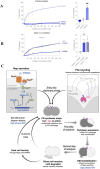Bacteriocin-like peptides encoded by a horizontally acquired island mediate Neisseria gonorrhoeae autolysis
- PMID: 39908303
- PMCID: PMC11798529
- DOI: 10.1371/journal.pbio.3003001
Bacteriocin-like peptides encoded by a horizontally acquired island mediate Neisseria gonorrhoeae autolysis
Abstract
Neisseria gonorrhoeae is a human-specific pathogen that causes the important sexually transmitted infection, gonorrhoea, an inflammatory condition of the genitourinary tract. The bacterium is closely related to the meningococcus, a leading cause of bacterial meningitis. Both these invasive bacterial species undergo autolysis when in the stationary phase of growth. Autolysis is a form of programmed cell death (PCD) which is part of the life cycle of remarkably few bacteria and poses an evolutionary conundrum as altruistic death provides no obvious benefit for single-celled organisms. Here, we searched for genes present in these 2 invasive species but not in other members of the Neisseria genus. We identified a ~3.4 kb horizontally acquired region, we termed the nap island, which is largely restricted to the gonococcus and meningococcus. The nap island in the gonococcus encodes 3 cationic, bacteriocin-like peptides which have no detectable antimicrobial activity. Instead, the gonococcal Neisseria autolysis peptides (Naps) promote autolytic cell death when bacteria enter the stationary phase of growth. Furthermore, strains lacking the Naps exhibit reduced autolysis in assays of PCD. Expression of Naps is likely to be phase variable, explaining how PCD could have arisen in these important human pathogens. NapC also induces lysis of human cells, so the peptides are likely to have multiple roles during colonisation and disease. The acquisition of the nap island contributed to the emergence of PCD in the gonococcus and meningococcus and potentially to the appearance of invasive disease in Neisseria spp.
Copyright: © 2025 Poncin et al. This is an open access article distributed under the terms of the Creative Commons Attribution License, which permits unrestricted use, distribution, and reproduction in any medium, provided the original author and source are credited.
Conflict of interest statement
The authors have declared that no competing interests exist.
Figures




Similar articles
-
A variable genetic island specific for Neisseria gonorrhoeae is involved in providing DNA for natural transformation and is found more often in disseminated infection isolates.Mol Microbiol. 2001 Jul;41(1):263-77. doi: 10.1046/j.1365-2958.2001.02520.x. Mol Microbiol. 2001. PMID: 11454218
-
AmiC functions as an N-acetylmuramyl-l-alanine amidase necessary for cell separation and can promote autolysis in Neisseria gonorrhoeae.J Bacteriol. 2006 Oct;188(20):7211-21. doi: 10.1128/JB.00724-06. J Bacteriol. 2006. PMID: 17015660 Free PMC article.
-
Evolution and exchange of plasmids in pathogenic Neisseria.mSphere. 2023 Dec 20;8(6):e0044123. doi: 10.1128/msphere.00441-23. Epub 2023 Oct 18. mSphere. 2023. PMID: 37850911 Free PMC article.
-
[MOLECULAR MECHANISMS OF DRUG RESISTANCE NEISSERIA GONORRHOEAE HISTORY AND PROSPECTS].Mol Gen Mikrobiol Virusol. 2015;33(3):22-7. Mol Gen Mikrobiol Virusol. 2015. PMID: 26665738 Review. Russian.
-
Neisseria gonorrhoeae Antimicrobial Resistance: Past to Present to Future.Curr Microbiol. 2021 Mar;78(3):867-878. doi: 10.1007/s00284-021-02353-8. Epub 2021 Feb 2. Curr Microbiol. 2021. PMID: 33528603 Review.
References
MeSH terms
Substances
Grants and funding
LinkOut - more resources
Full Text Sources
Molecular Biology Databases
Research Materials
Miscellaneous

